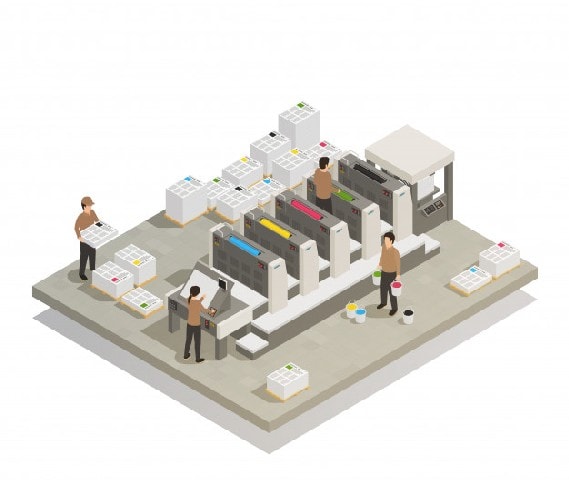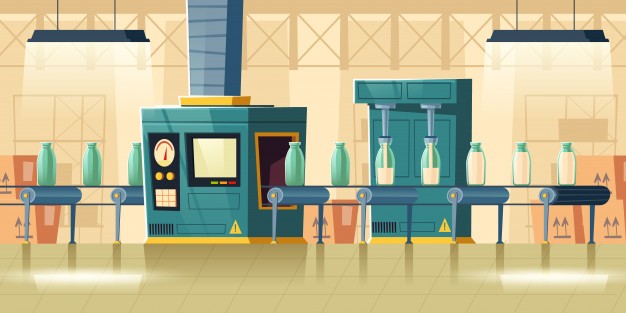Table of Contents
Definition
Total productive maintenance is also popularly known as TPM and is defined as an approach towards equipment maintenance. Its objective is to attain one of the best production processes by increasing safety, efficiency and productivity levels.
The focus of the total productive maintenance is on keeping all the equipment in top condition to minimize the chance of delays and breakdown during the manufacturing process.
Meaning of total productive maintenance
The total productive maintenance is described as a method that integrates both equipment maintenance and manufacturing process for overall improvement in the business process and increasing equipment availability.
Total productive maintenance is a proactive approach that deals in the comprehensive management of processes, people, environment and systems. In the organizations which have implemented the process of total productive maintenance, the entire team plays an essential role as the responsibilities are shared between operators and maintenance experts.
The process of total productive maintenance empowers operators to maintain the machinery and the equipment to reduce cycle times, improve productivity and eliminate defects on time. It enhances equipment-maintenance via team-based activities to accelerate equipment performances.
Objectives
The objectives of total productive maintenance are as follows-
- Minimize cost
- Equipment reliability
- Reduce accidents
- Increased ownership amongst the employees
- Sharing of experience and knowledge
- Achieving goals
- Optimized work schedules of every employee
- Efficient workforce
- Avoid wastage
- Enhanced employee skills
- Production of goods without compromising on quality
- Non-defective goods to be sent to the consumer market
- Producing goods at the earliest possible time via zero breakdown
- Involving people in all organizational levels
- Rectifying customer complaints
- Keeping the workplace clean and safe
Key features
The key features of total productive maintenance are as follows-
- It involves employees at every level across all the departments
- Incorporates autonomous maintenance in the operator’s daily routine
- Starts group activities to monitor the usage and implementation of total productive maintenance throughout the organization
- Maximize the use and effectiveness of equipment
- Shared responsibility for routine minor repairs, maintenance, cleaning and inspection
8 Pillars of total productive maintenance
The eight pillars of total productive maintenance are focused on preventive and proactive techniques for making improvements in equipment reliability. The pillars are as follows-
1. Autonomous maintenance
One of the pillars of total productive maintenance is autonomous maintenance where operators are responsible for maintenance and adjustments of machines like inspection, lubricating and cleaning. The advantages of autonomous maintenance are
- Boosts the knowledge of the operator about his equipment
- Results in skilled and motivated employees
- Provides greater ownership to the operator of their equipment
- Makes sure that the equipment is lubricated and cleaned
- Identifies any emerging issues so that they cannot disrupt productivity
- The maintenance crew is free to handle high-level tasks
2. Focused improvement
One of the pillars of total productive maintenance is focused improvement where employees in small groups work proactively to attain improvements in equipment operation and that too regularly.
It ensures the working of cross-functional teams together to identify the root cause of the problem and apply the necessary solutions for continuous improvement. The advantages of focused improvement are
- Integrating the collective talent of an organization to create a system for regular and continuous improvement
- Identifying and resolving recurring problems with the help of cross-functional teams
3. Quality management
One of the pillars of TPM is quality management. It includes detecting and preventing design error in production processes using lean tools. The advantages of quality management are
- Reducing numerous defects
- Targeting quality issues to remove the root causes of defects
- Minimizing costs by identifying defects at an early stage
4. Planned maintenance
One of the pillars of TPM is planned maintenance. It includes scheduling predictive and preventive maintenance routine based on behavior, history and sensor data of the machine. Its advantages are
- Minimizing inventory via better control of parts that are prone to failure and wear-and-tear
- Planning maintenance for the time when equipment is not reserved for production
- Minimizing unplanned stop time
5. Education and training
This pillar of total productive maintenance achieves desired goals and objectives by filling in the knowledge gaps of the employees. It initiates coaching and training programs to improve the skills of its employees regularly.
Machine operators can develop maintenance skills and some managers are trained at improvement strategies. The advantages are
- Managers are provided training on the development and coaching of an employee
- Maintenance staff learn preventative and proactive maintenance training
- Operators learn to identify emerging issues and maintain equipment
6. Early equipment management
One of the pillars of total productive maintenance is early equipment management. It is related to the designing stage and its objective is to design a machine so that it becomes easy to maintain and operate it. Its advantages are
- Employee involvement and practical review before installation makes the machine robust
- It is easy to reach planned levels in performances at a faster pace because of minimum issues at the start-up stage
7. Administrative and office total productive maintenance
One of the pillars of total productive maintenance is administrative and office total productive maintenance. It aims at implementing the total productive maintenance principles in the administrative functions like scheduling, procurement and order processing. The advantages are
- Addressing the issue of waste in administrative functions
- Supporting production with the help of improved administrative functions
8. Safety, health, environmental conditions
One of the pillars of total productive maintenance is safety, health, environmental conditions. It deals in setting standards in the workplace to eliminate potential safety, health, and environmental risk. The advantages are
- Eliminates risk to the health and safety of an employee
- Puts its focus on providing an accident-free workplace
5S of total productive maintenance
The 5S is a methodology that aims at eliminating unnecessary items by organizing the remaining ones in the best possible manner. It has put its onus on developing behavior to keep the workplace organized.
The 5S describes the necessary steps of an organizational process for well-running equipment and a well-organized work environment. Due to the implementation of 5S, it has become easier to spot issues like material spills, fluid leaks, etc. and find the necessary parts and tools.
- Seiri ( Sort ) – The first S of 5S is Seiri or Sort, and it eliminates unnecessary equipment and materials in the workplace
- Seiton ( Straighten )- The second S of 5S is Seiton or Straighten, and it tries to organize the remaining items to maintain and define clean locations for materials, machines, and tools
- Seiso ( Shine )- The third S of 5S is Seiso or Shine, and it deals in the implementation of cleaning practices regularly. It segregates various cleaning areas and assigns a team to every one of them for inspection.
- Seiketsu ( Standardize )- The fourth S of 5S is Seiketsu or Standardize. It has put its onus on creating standards for the activities mentioned above
- Shitsuke ( Sustain ) – The Fifth S of 5S is Shitsuke or Sustain, and its objective is to ensure the application of all standards to make the system sustainable
Advantages
The advantages of total productive maintenance are as follows-
- Increased availability of equipment – The process of total productive maintenance assist in performing preventive activities and maintenance inspections to minimize equipment failures. The operators and workers gather information about machine downtime so that it can predict potential failure and their causes. Eliminating the causes of failure helps to increase equipment availability
- Improved equipment performances – The maintenance staff and equipment operators conduct preventive activities and inspections of equipment regularly. They identify poor performances of equipment and diagnose the cause of declining performances. The total productive maintenance process eliminates reasons to improve performance efficiency
- Boost in equipment quality levels – The objective of total productive maintenance is to identify a proper maintenance plan and key control characteristics to prevent performance degradation
- Fewer breakdowns – As operators are always on the look-out identifying issues the chance of breakdowns is minimum
- Safe environment – Timely maintenance leads to fewer breakdowns, and this results in a safe and healthy workplace environment
- Low manufacturing costs – With the increase in OEE or overall equipment efficiency, there is a decrease in production costs. It is a fact that high productivity levels equal to greater profits
- Reduction in the total workforce
- Customer complaints are rectified quickly
- A decrease in pollution levels
- The favorable change in the operator’s attitude
- Higher confidence level in the employees
Disadvantages
The disadvantages of total productive maintenance are as follows
- It is considered a time-consuming process that is a challenge to implement
- The method of total productive maintenance is expensive and every company cannot afford to implement it in their workplace
OEE and the six significant losses
Overall equipment effectiveness is commonly known as OEE and is described as a metric to identify truly productive planned production time in percentage. It is used to support the initiatives taken by total productive maintenance by tracking progress accurately. Some facts about OEE are
- A score of 100% OEE is termed as perfect production
- A score of 85% OEE is termed as world-class for discrete manufacturers
- A score of 60% OEE is termed as typical for discrete manufacturers
- A score of 40% OEE is termed as one without TPM or lean programs
Understanding the six significant losses
The six big losses that total productive maintenance identifies that can interfere with the production are
- Failure in equipment resulting in an unexpected loss of time
- Commissioning and downtime that results in loss of time during a new operation.
- Minor failures and waits during normal operational activities that cause loss of time because of small obstructions
- Reducing operation speed that leads to production loss as the design speed is not achieved
- Defect in the process leads to production loss because it will take time to complete unfinished activities
- Loss of time because of probationary or idle period or because of commissioning of a new process
Steps involved in the implementation of total productive maintenance
Stage 1
1. Identify pilot area
Having a pilot area before the application of total productive maintenance is an advantage as it helps in gaining acceptance from the workforce. Consider the following facts in this initial evaluation of total productive maintenance level-
- What is the easiest to improve? Selecting such equipment will yield positive and immediate results
Pros – It is the best opportunity for quick results
Cons – Does not test the total productive maintenance program as other available options
- Where is the bottleneck? Selecting equipment based on where production is being held up will offer instant payback by increasing output.
Pros – There is an immediate boost in total output, and it offers fast payback
Cons – Higher risk option
- What is most problematic? Fixing troublesome equipment strengthens support for the total productive maintenance program.
Pros – Solving problems strengthens support
Cons – less payback
If an organization has limited experience or assistance related to total productive maintenance or TPM program, then the best choice is easiest to improve equipment
If an organization has moderate or strong expertise related to total productive maintenance or TPM program, then the best option is the bottleneck equipment because it becomes easy to reduce potential risks by building stock temporarily
Make sure to include a broad base of associated employees including managers, maintenance staff and operators in the pilot selection process. Use a project board to keep everyone updated
Stage2
Restore equipment to a prime operating condition
The concept at this stage revolves around the 5S system as well as autonomous maintenance. It is essential to use the 5S system and keep the equipment in prime condition by the development of a master plan for total productive maintenance implementation. This is possible by
- Posting photos of the area and equipment in its current state on the project board
- Remove waste, debris, unused tools and clear the area
- Organize the components and tools that are used regularly
- Cleaning the surrounding area and equipment
- Posting the improved photos on the project board
Stage 3
Measure OEE
Track OEE either via automated software or manually for the target equipment regularly to derive a data-driven confirmation about the success of the program. Categorize the entire unplanned stoppage event to know where the stoppage is occurring.
Stage 4
Address significant losses
Once an organization has a data-driven idea of its losses, it is the time to address the issues through the formation of a total productive maintenance committee. A cross-functional team is created that includes supervisors, maintenance staff and operators to dissect the OEE data and identify the leading cause of the loss.
Stage 5
Implement planned maintenance – Integrate proactive maintenance techniques for implementation of total productive maintenance program. Choose the components that require proactive maintenance. Identify stress points and use intervals to establish wear levels. Now design a replacement schedule of al the wear-prone elements and develop a standardized process to create work orders.
Liked this post? Check out the complete series on Operations Management




